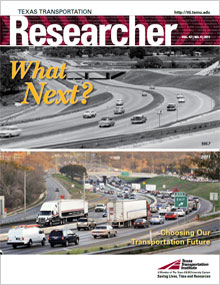Facing the Challenges That Lie Ahead

The United States continues to face population increases and changing demographics. This trend is particularly true in Texas, where the population boom of the past 10 years has resulted in a rapid urbanization of rural areas. At the same time, some rural parts of the state have experienced population decreases.
This trend has become a hot topic for transportation planners seeking to find proactive solutions for transit in rural America, the theme of a recent presentation by Texas Transportation Institute (TTI) Transit Mobility Program Manager Linda Cherrington. On Aug. 17, Cherrington spoke to representatives from the U.S. Department of Transportation (U.S. DOT) about challenges and opportunities for transit in rural America. The lecture was sponsored by the U.S. DOT Research and Innovative Technology Administration as part of the Transportation Innovation Series. The opportunity was facilitated by Melissa Tooley, director of TTI’s University Transportation Center for Mobility.
“There is still a two-pronged challenge to transit in rural America,” says Cherrington. “One is that there are parts of rural America that are growing in population, particularly around metropolitan areas. Transportation planners face a new set of challenges in meeting their needs. The other side of the coin is that there are areas that are not increasing in population, but where the population continues to age. People in these areas tend to become more isolated but still have travel needs for basic activities. Rural transit providers have to deal with both issues.”

According to Cherrington, Texas is an ideal case study because the state’s recent population trends match that of the United States.
“Texas has rapidly growing urban centers such as the I-35 corridor, and then we have large areas that are losing populations,” says Cherrington. “We have done a lot of research that is Texas focused but can be applied on a national level.”
In her presentation, Cherrington noted the opportunities for transit, which include:
- providing basic mobility options — increasingly important for an older population,
- providing a link between workers and rural-area industries,
- pooling resources to more efficiently serve a given region and prevent service duplication, and
- using transit to provide access to the diverse array of opportunities found in urban areas to those living in rural communities.
To view a webcast of Cherrington’s presentation, visit http://mediasite.yorkcast.com/webcast/Viewer/?peid=40833c39bea6443a997901e6b8315de01d.
